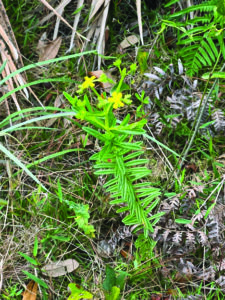Upper Tampa Bay Conservation Park 3-5-23
8001 Double Branch Rd, Tampa, FL 33635
Participants Ed Shindle and Dr. Rob Norman
Time 10am to 1pm
“The Upper Tampa Bay Park is a Hillsborough County park located on the Double Branch Peninsula, approximately three miles southeast of Oldsmar, which is west of Tampa. The park has been only minimally developed because the environment is so fragile and sensitive.”
The Nature Journal allows us to see the enormous variety of species in one area!
Rusty Leonia, Staggerbush (Lyonia ferruginea)
• Also known as Rusty staggerbush, Rusty lyonia is a long-lived evergreen flowering shrub
• It occurs naturally in scrub, scrubby flatwoods, xeric hammocks and moist pine flatwoods.
• Flowers are small, white, urn- or bell-shaped and borne in clusters. The flowers typically appear in spring and are attractive to butterflies and bees; fruits are eaten by birds and other wildlife.
• All parts of the plant have a rusty pubescence, but it is most prominent on leaf undersides. Newly emerging leaves also have a rusty color. Trunks are usually crooked or irregularly shaped. Fruit is a small oval capsule.
• The species epithet ferruginea is from the Latin ferrugo (ferrum), meaning “rust” or “iron”. It, along with its common descriptor “rusty,” refers to the many rust-colored hairs that cover the plant’s leaves, stems and trunk.
The common bracken fern (Pteridium aquilinum) (bracken, brake or common bracken), also known as eagle fern, is a species of fern occurring in temperate and subtropical regions in both hemispheres. Originally native to Eurasia and North America, the extreme lightness of its spores has led to it achieving a cosmopolitan distribution. Common bracken was first described as Pteris aquilina by Carl Linnaeus, in Volume 2 of his Species Plantarum in 1753. The origin of the specific epithet derived from the Latin aquila “eagle.”
https://www.inaturalist.org/taxa/52681-Pteridium-aquilinum
Raccoon tracks
Raccoon tracks can be found throughout the United States in almost all habitat types. They are a member of the Procyonidae family, which also includes the ringtail and coati. Raccoons are omnivorous, eating a wide range of foods from crayfish and frogs, to berries and eggs. Raccoon footprints are hand-shaped with a diameter that measures 2 to 3 inches across. They register five finger-like toes in both front and hind feet and also often register small claws.
Raccoons have a unique walking gait that they utilize when traveling and foraging. This unique walking gait results in a trail pattern where front and hind tracks from opposite sides of the body register next to each other, as in the photo below. Step lengths in this gait vary from 10 to 18 inches. Raccoons will also utilize lopes and gallops when avoiding danger.
https://www.wildernesscollege.com/raccoon-tracks.html
Saw Palmetto
The Saw palmetto palm tree is indigenous to the eastern provinces of the United States. The Seminole tribal folk of Florida used its fruit in the medical field. Besides, it has traditional usage as a remedy for symptoms of urinary problems related to the enlargement of the prostate gland, (this is also known as benign prostatic hyperplasia or otherwise BPH); in addition saw palmetto is used to alleviate unceasing pelvic pain, reduction in the urge for sex, disorders related to bladder, loss of hair, prostate cancer and imbalance of the hormones.
Saw Greenbrier (Smilax Bona-Nox)
Leaves are Semi-evergreen. Leaves becoming thick and stiff with age. Three-lobed, ovate, or fiddle-shaped; 5–14 cm long and 1–12 cm broad. Upper leaf surface shiny and green, commonly variegated with gray or pale green blotches.
 Paw Paw
Paw Paw
Netted pawpaw (Asimina reticulata) is a deciduous flowering shrub found in pine and scrubby flatwoods, sandhills and coastal scrub habitats throughout peninsular Florida. It blooms late winter through spring, producing many flowers that attract a wide variety of butterflies. The plant is a larval host for the Zebra swallowtail and Pawpaw sphinx moth. The fruits, which appear in spring and summer, are a favorite of birds and small mammals.
St. John’s Wort (Hypericum perforatum)
St. John’s wort has a history of use as a medicine dating back to ancient Greece, where it was used for a range of illnesses, including various nervous disorders. St. John’s wort also has antibacterial, antioxidant, and antiviral properties. Because of its anti-inflammatory properties, it has been applied to the skin to help heal wounds and burns. St. John’s wort is one of the most commonly purchased herbal products in the United States.
In recent years, St. John’s wort has been studied extensively as a treatment for depression. Most studies show that St. John’s wort may help treat mild-to-moderate depression, and has fewer side effects than most other prescription antidepressants. But it interacts with a number of medications, so it should be taken only under the guidance of a health care provider.
Two Plant Identification Apps used for this article — Seek and Picture This
Where can you find all of these wonderful beauties of nature?
Get out and enjoy The Great Florida Outdoors!
Dr. Norman is an advanced master naturalist graduate of the FMNP program from UF and a board-certified dermatologist based in Tampa and Riverview. He can be reached at 813-880-7546.

61 books (series editor of 13) ● 300+ articles ● 25 videos and films
● 16 photo calendars and exhibits ● 4 music CDs
Tampa Bay Medical Hero Award (2008)
● Hadassah Humanitarian Award (2012)
To order books click on these links:
Trade (Popular) Books
Clinical Books
Instructional Books
Read more of Dr. Norman’s articles here.
https://dunndealpublications.com/dr-robert-normans-articles/
